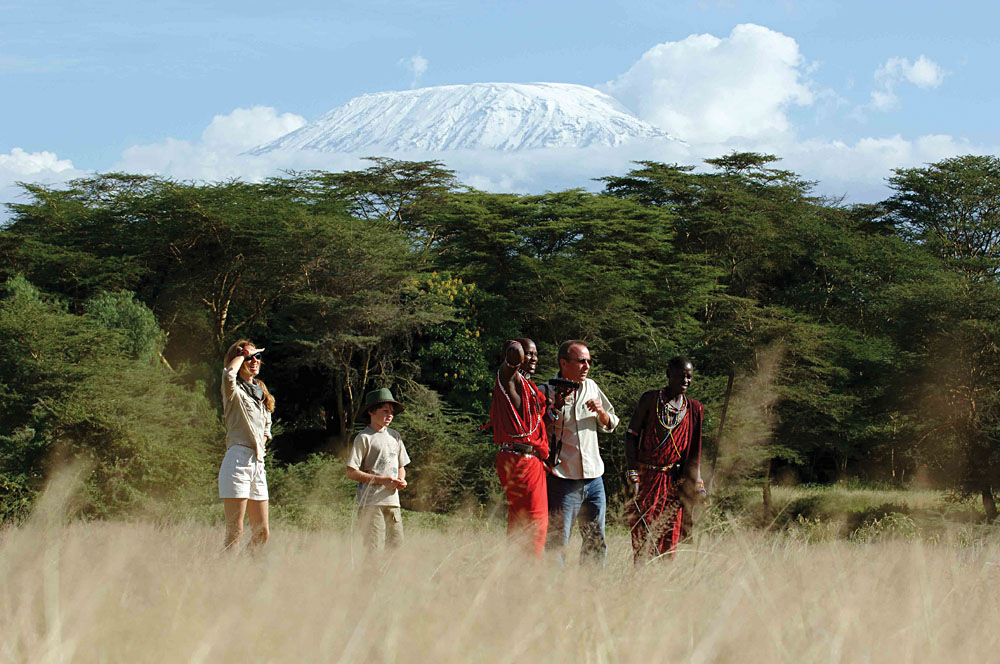Get to know Amboseli National Park on your Kenya vacation. It is the country's second most popular national park, after the famed Masai Mara. Located 240 kilometres/150 miles south of Nairobi, Amboseli lies directly on the Kenya/Tanzania border. While it is in Kenya, rising up into the sky directly across from the park, is the highest mountain in Africa, Mount Kilimanjaro in Tanzania. This proximity to the mountain is important to the park. To explain, Amboseli comes from a Masai word meaning, "salty dust”. During the dry season, there is a lack of water. Mount Kilimanjaro provides an underground water supply which is funneled to two clear water springs in the middle of the park. Naturally, wildlife’s survival depends on water.
When are the Best Times to visit Amboseli?
The months between June and November are the dry season and generally considered to be the best time to visit, when the animals are most visible. Between December and May is the green season when rain showers can happen at any time, although that's largely in March and April. At this time the animals disperse and the grass cover increases, making wildlife viewing a lot more challenging. But the upside is that the bush is lusher and has plenty of wildflowers.
Is Mount Kilimanjaro Always Visible?
No, not all the time. The best time to view Mount Kilimanjaro from the park is at dawn and sunset, when the clouds lift and the light is clear and soft.

Experience the Wildlife
The system of swamps makes this low-rainfall area one of the best wildlife-viewing experiences in the world. First of all, Amboseli is renowned for the large herds of free-ranging African elephants found here. They are easy to see and photograph due to the flat and naked terrain. Amboseli's elephants, which are said to be among the biggest in the country, are fond of the swamps. Other animals to view are Cape buffalo, impala, lion, cheetah, black rhino, spotted hyena, jackal, wild dog, warthog, mongoose, giraffe, zebra, and wildebeest. Bird watchers will be happy with a list that tops 400 species of birds, including pelican, flamingo, kingfisher, African fish eagle, ibis, secretary bird, crowned crane, grey and Goliath herons, cattle egret, black-winged stilt, little grebe, Egyptian goose, martial eagle, pigmy falcon, Masai ostrich, marabou stork, white-backed vulture, lappet-faced vulture, yellow-necked spurfowl, Kori bustard, and hornbills. After the rains, the park attracts large populations of water birds.
More About the Elephants
The Amboseli Elephant Research Project is a long-term research project operated by the non-profit Amboseli Trust for Elephants. The project is the longest running study of elephant behaviour in the wild, and has gathered data on the life histories and patterns of more than 1700 individual elephants. This is in large part thanks to the work of Dr. Cynthia Moss, whose books include The Amboseli Elephants and Elephant Memories. Although the camp is not open for casual visits, it is possible, with prior arrangement, to arrange a one-hour lecture at the camp during which the researchers explain their work and other related issues of elephant conservation.

Meet the Masai People of Amboseli
The Amboseli territory belongs to the land of the Masai, the legendary tribe of nomad warriors and shepherds that feed on a mixture of blood and milk. They still live today in the reserve surrounding the park the way they always have, grazing their herds on the plains, and continually moving their households - searching for the best pastures. Restricted today by encroachment of their territories, the Masai build their homes using wooden sticks and poles plastered with cow manure. With their long and slender bodies, their coloured clothes, and their plated and red-stained hair, the Masai make for exceptional photographs, but never take pictures of them without their consent.

So, with the ever-dramatic presence of Mount Kilimanjaro and the amazing variety of wildlife, Amboseli National Park should be one of your first choices while on your Kenya vacation. For tour ideas and information on Amboseli National Park, visit us at www.goway.com.
Robert was born in England and while in high school, he took his first venture outside of the country to Switzerland on a school trip. This was the start of a long journey exploring the world. He moved to Canada where he continued his career working for travel organizations including many years as Vice President of Canada's largest travel organization. Later, he spent 20 years with Goway Travel. His travels have taken him to over 80 countries finding out that every single one of them has something interesting to offer. Robert’s advice to all travellers: wherever you venture, always find out what is around the next corner.
Get Inspired
Travel Stories to Inspire You.
Newsletter
Unlock Even More
Sign up to our newsletter to unlock travel Specials, Inspiration, and Expert Guides right to your inbox.




